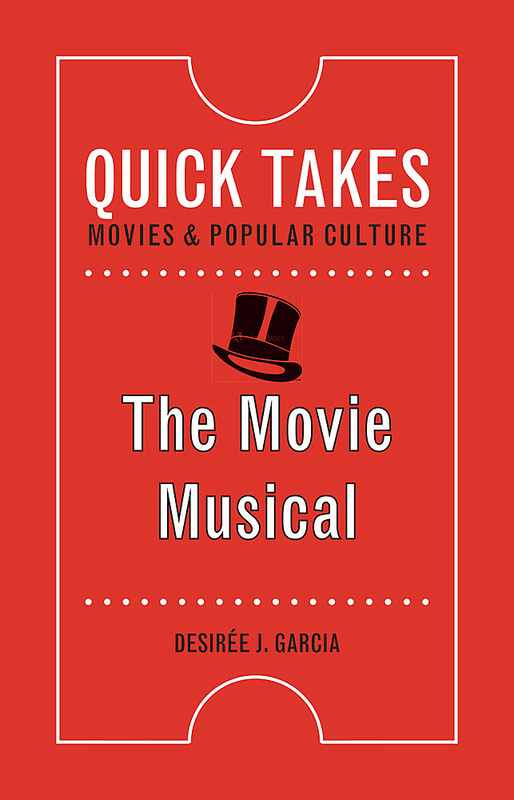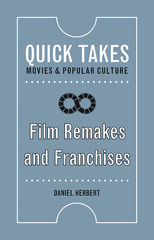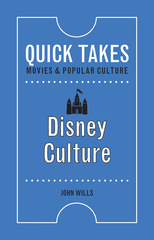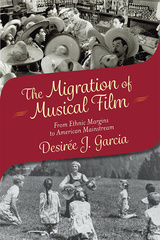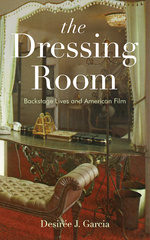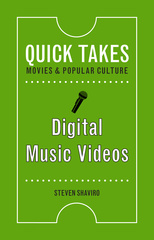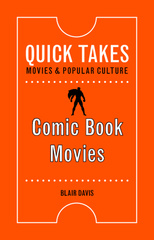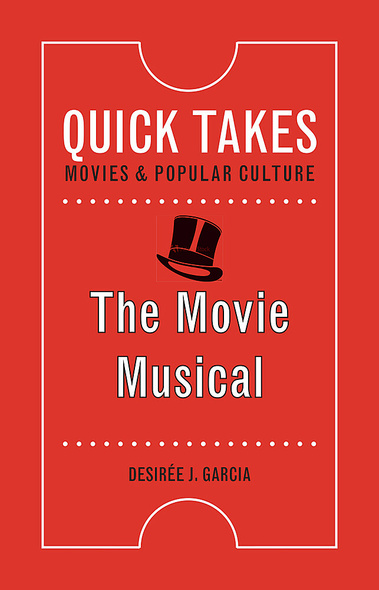
152 pages, 4 1/2 x 7
Paperback
Release Date:15 Jan 2021
ISBN:9781978803787
Hardcover
Release Date:15 Jan 2021
ISBN:9781978803794
The Movie Musical
Rutgers University Press
Putting Asian and European musicals into conversation with Hollywood classics like Singin’ in the Rain and La La Land, this study demonstrates the flexibility and durability of the genre. It explores how the movie musical mediates between nostalgia and technical innovation, while foregrounding the experiences of women, immigrants, and people of color.
In her follow-up to The Migration of Musical Film, Desiree Garcia discards the ‘boom and bust’ narrative stubbornly bonded to the Hollywood musical—along with its link to ‘mindless’ escapism. Through attentive, close readings, The Movie Musical unearths ways that musicals accommodate changing times and audiences, acknowledging their insights about the cultures and audiences in which they work—and actually help construct. A welcome addition to film musical and genre scholarship.
‘S Wonderful! ‘S Marvelous! How can such a diverse genre be covered so well in so short a book? Desirée Garcia’s The Movie Musical adeptly surveys its long history and recurring conventions while offering a global perspective that enables her to discuss the genre in original and innovative ways.
Dartmouth College professor and author Desirée J. Garcia’s tightly packed and deeply researched study examines the genre’s illumination of more than just our collective daydreams and escape impulses.
The Movie Musical covers the genre’s history and conventions well while offering some interesting new perspectives on what the musical is, what it has done, and what it can do.
DESIRÉE J. GARCIA is an associate professor in the Latin American, Latino, and Caribbean Studies Program and an affiliate in the Film and Media Studies Department at Dartmouth College. Her many publications include the book The Migration of Musical Film: From Ethnic Margins to American Mainstream (Rutgers University Press). She also starred in La La Land director Damien Chazelle’s first musical, Guy and Madeline on a Park Bench.
Introduction
Over its history, the movie musical has had much to atone for. Made possible by the film industry’s embrace of sound cinema in the late 1920s, the creation of the movie musical appeared to signal the end of an era for the advancement of cinematic form. As Andrew Sarris observed in a 1977 essay, the new genre assumed cultural guilt as the “slayer of silent cinema”. (Sarris in O’Brien, 2019) Upon its inception and with the release of films like The Jazz Singer(Alan Crosland, 1927) and Show Girl (Alfred Santell, 1928), the musical was commonly viewed as the product of crass commercialism and bawdy sentimentality rather than intellectual engagement and aesthetic sophistication. This new category of cinema, defined according to its inclusion of singing and dancing to varying degrees and intents—a definitional schema that scholars have debated ever since (see Griffin 2018)—operated according to a logic of entertainment rather than art.
Fast forward to the 1960s and the musical again came under fire as an inferior art form. The massive international hit that was The Sound of Music (Robert Wise 1965) convinced the Hollywood studios that making more such musical blockbusters would produce the same enormous box office receipts. When that scenario did not materialize as expected, so the narrative goes, the film studios experienced a massive recession, signaling an end to the “golden age” of Hollywood movies. Again, the commercialism and artificiality of the genre was to blame. Critics derisively called The Sound of Music “The Sound of Money”. (Variety 1966) And in her now infamous review of the film, Pauline Kael referred to it as “the sugar-coated lie that people seem to want to eat,” that it was “self-indulgent” and that it conjured “cheap and ready-made” responses from the public. (Kael 1966)
For many decades, histories of Hollywood film framed The Sound of Music as the single film responsible for the near downfall of the studios and the genre itself. The subsequent musicals made in The Sound of Music’s image included Camelot (Joshua Logan 1967), Thoroughly Modern Millie (George Roy Hill 1967), Doctor Doolittle (Richard Fleischer 1967), Star! (Robert Wise 1968), Funny Girl (William Wyler 1968), and Hello, Dolly! (Gene Kelly 1969). When these films lost money, the viability of the musical came under question. Contemporary observers like producer Cy Feuer countered this narrative arguing that scores of people went to see these films, but their grossly inflated budgets prevented them from turning a profit. (Feuer in Tusher 1972) In recent decades, scholars have revised this history of crisis and downfall, including Steven Neale (2006), Brett Farmer (2010), Matthew Kennedy (2014), and Sean Griffin (2018), but the infamy that surrounds The Sound of Music and the movie musical in general lives on.
The Hollywood studios themselves have participated in the narrative that musicals are just fluff. One only has to recall Frank Sinatra’s opening monologue to That’s Entertainment! (Jack Haley Jr. 1974), a compilation film made up of musical numbers from MGM’s golden age, the period from the 1930s to the 1950s. He faces the camera and states as a matter of fact, “Musicals were fantasy trips for the audiences of their day….” “They may not tell you where our heads were at,” he continues, “but they certainly tell you where our hearts were at.” Pitched to 1970s audiences weary of political corruption, war, and racial conflict, That’s Entertainment! fashioned itself the means by which we could return to a simpler moment in time.
The criticism of the movie musical underlying all of these assessments of the genre is, of course, escapism. And it is the criticism with which The Movie Musical is most engaged not only because it has framed much of the genre’s history to this point, but also because it continues to be the dominant lens through which we encounter contemporary musicals. Escapism was the dominant critique of Damien Chazelle’s La La Land (2016), which waxed nostalgic for Hollywood musicals and films from the golden age. Yet paradoxically, these same criticisms went hand in hand with taking the film to task for its representation of race and the authorship of black cultural forms like jazz.[1] So while La La Land was escapist and seemingly easily dismissed, many of its lay viewers spent significant time dissecting and critiquing the film as a central text in the debate about culture and representation.
I reference La La Land because it is emblematic of a paradox in musical film history: for all of their supposed irrelevance to the real world, musicals continue to be made and continue to be popular. Love them or hate them, evidence is everywhere that they still resonate across modes of production and mediums of dissemination. See for example the success of Randy Rainbow’s YouTube channel, which he uses to perform numbers from musicals, but with rewritten lyrics that comment on the contemporary political moment. Or, consider the many shows on television that reproduce and regenerate the musical such as reality contest shows (American Idol 2002-, So You Think You Can Dance 2005-, The Voice 2011), series like Glee (2009-2015) and Crazy Ex-Girlfriend (2015-2019), flash mobs that appeared worldwide after the releases of La La Land and The Greatest Showman, and, of course, improvised and orchestrated public sing-alongs for The Rocky Horror Picture Show (Jim Sharman 1975), The Sound of Music, Frozen (Chris Buck and Jennifer Lee, 2013), and The Greatest Showman (Michael Gracey 2017) in entertainment venues large and small.[2]
A problem of escapism as a critique is that it tends to end the discussion. It dismisses the genre without being thoughtful about why musicals continue to be made over and over again. We know from cultural theorists like Richard Dyer and Lawrence Levine that audiences do their escaping intentionally. As Dyer argues, musicals have never been “only entertainment,” as they often serve the function of offering that which is lacking in our lives. (Dyer 2002) Choosing the musical for their brand of escapism, as opposed to the escapism provided by other film genres or forms of popular culture, audiences determine, as Lawrence Levine has argued, “what kinds of fictions, myths, fantasies they require, not primarily to escape reality but to face it day after day after day.” (Levine 1992, 1375) In studying why audiences continue to support the musical, I have come to the conclusion that it is not about what audiences are running away from, but what they are running toward.
One intervention to be made here is an argument for the genre’s continuity. In order to understand how and why the genre is still with us, we must get past the narratives of “crisis and rupture” that have persisted. With each new musical film to be released by the studios, critics announce that the musical may not be dead after all. In an internationally syndicated online article on Rappler.com, “A Musical Resurgence has Hollywood Changing its tune,” published on the heels of La La Land’s release, the writer declares that the “musical is taking center stage once again in Hollywood” and that Hollywood “is falling back in love with the movie musical” (emphasis mine). (April 19, 2018) The problems here are twofold. First, the article suggests that the musical fell out of favor at some point, but now has returned to a place of cultural acceptance. And second, the article focuses exclusively on Hollywood and therefore does not take into account the histories of musical film traditions and international auteurs engaged with the genre that have persisted across time. Part of the issue is one of definition as Sean Griffin has observed: “there has been far too much emphasis on the comfort of the familiar structure of the integrated musical, and not enough celebration of liberation from that definition.” Writing a history of the American film musical from its origins to the present, Griffin demonstrates how “the film musical has survived ably, by evolving into new patterns and structures regardless of attempts to keep it locked in place.”[3] (Griffin 2018, 8) This volume takes up Griffin’s project of demonstrating the elasticity of the genre beyond the period of Hollywood’s golden age. But I am also interested in considering the genre more broadly as an international one and one made by directors who have been historically underrepresented in Hollywood’s production of musicals, including women, Latinx filmmakers, and black filmmakers. To do so requires a revisioning of the genre’s historiography and a reckoning with the way the genre’s history has been told within Hollywood-centric paradigms.
To be sure, scholars have initiated discussions about the movie musical in other cultural traditions and contexts. In the edited collections by Corey K. Creekmur and Linda K. Mokdad (2013) and Steven Cohan (2010), a range of scholars analyze musicals from multiple countries and over time. The call to rewrite the genre’s history with an acknowledgement of international production has been made by Adrian Martin (2003), Björn Norðfjörð (2013), Caryl Flinn (2016), Charles O’Brien (2019), and Kathryn Kalinak (2019). I contributed to this body of work with my previous book, The Migration of Musical Film: From Ethnic Margins to American Mainstream. (2014) Continuing in this vein, The Movie Musical treats the genre capaciously; it places Hollywood classics, independently produced films, and musicals from around the world in the same conversation.
Battling the notion that the genre’s escapism renders it meaningless to the real world, I divide this volume into three thematically organized chapters: the musical as archive; the musical as society; and the musical as mediation. In each, I investigate the ability of the genre to adapt to changing times, cultures, and audiences. Examples span from the earliest movie musicals in the 1920s to the present day in order to show continuities and shifts in form and narrative. And the thematic orientation of the book allows me to consider how the genre’s language manifests change and continuity across modes of production and geographic boundaries as well.
In “The Musical as Archive,” I examine the musical’s ability to make a case for itself to new audiences by functioning as its own archive. In other words, the musical documents its own history and uses its own historical materials to interpret its present. The earliest musicals house and revive past entertainment forms, such as vaudeville, musical comedy, and minstrelsy, in order to engage in nostalgia, but also to demonstrate that like the amusements of yesteryear, modern musicals are entertaining too. As musical films evolved, they archived past musicals, such as in Singin’ in the Rain (Stanley Donen and Gene Kelly, 1952). Archival references cross national boundaries as well. La La Land is a particularly rich example of a Hollywood musical that quotes from earlier Hollywood musicals like the Astaire-Rogers films, Chazelle’s first musical film Guy and Madeline on a Park Bench (2009), and French musicals like Jacques Demy’s The Umbrellas of Cherbourg (1964) and The Young Girls of Rochefort (1967). In La La Land’s case, the film self-consciously states its own genealogy, a genealogy that looks backward in order to find a path forward.
But perhaps the most intriguing instances of archiving have come from outside of the United States. Jane Feuer has argued that films like Strictly Ballroom (Australia, Baz Luhrmann 1992), Everyone Says I Love You (US independent, Woody Allen 1996), Shall We Dance (Japan, Masayuki Sui 1996), Little Voice (UK, Mark Herman 1998), Dancer in the Dark (Denmark, Lars Von Trier 2000), and Billy Elliot (Stephen Daldry 2000) are a subgenre of the musical proper, the international art musical. They share in the impulse to reference earlier Hollywood musicals, but from a significant distance. “Instead of representing the lead performers in old Hollywood musicals,” Feuer argues, the main characters “take up the position of spectators of old Hollywood musicals in a world where it is no longer possible to be Fred Astaire.” (Feuer 2010, 55). These musical films, in other words, catalog the spectatorship of movie musicals, demonstrating that, no matter how different lived reality is from the musical’s realm of fantasy, the genre still provides something generative. This archival project in which musicals reference other musicals (and musicals reference forms of movie musical spectatorship), has been a critical means by which the genre makes itself relevant to new audiences around the globe. In the films I discuss here, the characters’ worlds recall and temporarily resemble the qualities of song and dance sequences, only to return again to stark reality. But these moments are strategically important to surviving those realities, as when the female character in The Hole (Ming-liang Tsai 1998) imagines a life away from death and disease or when the animals in The Burden (Niki Lindroth Von Bahr 2017) give musical expression to their feelings of anomie. As John Limon has argued about contemporary directors’ use of The Sound of Music in globalized contexts of production, “escapism is where one goes to find what is inescapable.” (Limon 2016, 51) In The Hole and The Burden, the musical is both pleasure and pain. These musicals and many others reveal how the desire to escape and the inability to do so is a persistent narrative theme that finds its inspiration in present-day conditions.
In “The Musical as Society,” I take on the issue of authorship. If one were to focus exclusively on Hollywood, it would be easy to dismiss movie musicals as the products of a white male subjectivity. In telling stories about women, immigrants, and peoples of color, Hollywood musicals have consistently placed the reins of control in the hands of people who do not share those perspectives. If we look beyond Hollywood, however, we can find examples of filmmakers from marginalized positions in society who have used the musical genre as a means of critiquing society. This chapter begins with a discussion of how the Hollywood musical has identified social issues directly. It refutes the claim that the genre does not engage in social issues by using examples of musicals that address assimilation, including treatments of immigration and ethnicity (in The Jazz Singer, Alan Crosland 1927, for example), intolerance toward the working classes (in films like Gold Diggers of 1933, Mervyn LeRoy 1933, and Babes in Arms, Busby Berkeley 1939), and the distrust of social outsiders (The Music Man, Morton DaCosta 1962). But this chapter goes further to focus on musicals made outside and, in some cases, in defiance of the Hollywood model. The majority of the chapter analyzes three films that take the backstage musical, which tells stories about performers’ lives, as the means by which to revise the spectacularized representations and framings of Mexican Americans, black Americans, and women. The directors Luis Valdez (La Bamba1987), Spike Lee (Bamboozled 2000), and Sally Potter (The Tango Lesson 1997) appropriate the backstage musical in order to tell stories about ethnicity, race, and gender, respectively, in ways that upend the genre’s conventions that have alternately stereotyped and constrained representations of marginalized groups. Far from escapist, these interventions demonstrate the musical’s elasticity as a form and its ability to grapple with complexities in society.
Lastly, “The Musical as Mediation” assesses the genre’s relationship to media and technology over time and space. While the musical is rarely the genre that comes to mind when thinking about forms of mediation, its self-consciousness as an inheritor of past entertainment forms has prompted recognition of how new technologies, namely, sound cinema, have produced new forms, of which the musical is one. The genre’s nostalgic impulse, most developed by the folk musical subgenre, has repeatedly shown an investment in demonstrating how once new forms of technology in the past (the telephone, the trolley, the automobile) can be integrated into the project of holding families together and strengthening communities rather than weakening them.
This chapter foregrounds Irish filmmaker John Carney’s films, Once (2007), Begin Again (2013) and Sing Street (2016), as examples of musicals that employ mediation extensively in their narrative structure and form. Featuring main characters who are musicians rather than performers, Carney’s films insist on the experience of music, creating it, listening to it, and playing it, in contemporary contexts. And he demonstrates the multiple ways that music can be a mediating device for human connection. He foregrounds the materiality of print, broadcast, and recording media, in both analog and digital forms, to facilitate these interpersonal connections. His musicals offer an experience of mediated communion that overcomes modern ills such as the allure of celebrity and consumerism (Begin Again), the sense of social dislocation wrought by immigration (Once, Begin Again),t and divorce and teenage angst (Sing Street).
As this is a “quick take” on the musical, The Movie Musical cannot possibly cover all relevant examples of the points discussed here. With a thematic rather than chronological approach, I have tried to indicate some alternate approaches to the history of the movie musical that highlight its longevity as a highly adaptable and resilient cinematic language. And in order to make this volume an accessible point of entry to the study of the genre, I have deliberately chosen examples of films that are accessible on either DVD or streaming media so that students inside and outside of the classroom can read it alongside the films themselves. Moreover, with its expansive periodization and its emphasis on musicals made outside of Hollywood, I intend for this book to complement other studies of the musical already in existence. While entertainment and pleasure will always be associated with the genre, it is my hope that we can continue to approach the musical, in all of its diversity, with both our hearts and our heads.
Notes
Over its history, the movie musical has had much to atone for. Made possible by the film industry’s embrace of sound cinema in the late 1920s, the creation of the movie musical appeared to signal the end of an era for the advancement of cinematic form. As Andrew Sarris observed in a 1977 essay, the new genre assumed cultural guilt as the “slayer of silent cinema”. (Sarris in O’Brien, 2019) Upon its inception and with the release of films like The Jazz Singer(Alan Crosland, 1927) and Show Girl (Alfred Santell, 1928), the musical was commonly viewed as the product of crass commercialism and bawdy sentimentality rather than intellectual engagement and aesthetic sophistication. This new category of cinema, defined according to its inclusion of singing and dancing to varying degrees and intents—a definitional schema that scholars have debated ever since (see Griffin 2018)—operated according to a logic of entertainment rather than art.
Fast forward to the 1960s and the musical again came under fire as an inferior art form. The massive international hit that was The Sound of Music (Robert Wise 1965) convinced the Hollywood studios that making more such musical blockbusters would produce the same enormous box office receipts. When that scenario did not materialize as expected, so the narrative goes, the film studios experienced a massive recession, signaling an end to the “golden age” of Hollywood movies. Again, the commercialism and artificiality of the genre was to blame. Critics derisively called The Sound of Music “The Sound of Money”. (Variety 1966) And in her now infamous review of the film, Pauline Kael referred to it as “the sugar-coated lie that people seem to want to eat,” that it was “self-indulgent” and that it conjured “cheap and ready-made” responses from the public. (Kael 1966)
For many decades, histories of Hollywood film framed The Sound of Music as the single film responsible for the near downfall of the studios and the genre itself. The subsequent musicals made in The Sound of Music’s image included Camelot (Joshua Logan 1967), Thoroughly Modern Millie (George Roy Hill 1967), Doctor Doolittle (Richard Fleischer 1967), Star! (Robert Wise 1968), Funny Girl (William Wyler 1968), and Hello, Dolly! (Gene Kelly 1969). When these films lost money, the viability of the musical came under question. Contemporary observers like producer Cy Feuer countered this narrative arguing that scores of people went to see these films, but their grossly inflated budgets prevented them from turning a profit. (Feuer in Tusher 1972) In recent decades, scholars have revised this history of crisis and downfall, including Steven Neale (2006), Brett Farmer (2010), Matthew Kennedy (2014), and Sean Griffin (2018), but the infamy that surrounds The Sound of Music and the movie musical in general lives on.
The Hollywood studios themselves have participated in the narrative that musicals are just fluff. One only has to recall Frank Sinatra’s opening monologue to That’s Entertainment! (Jack Haley Jr. 1974), a compilation film made up of musical numbers from MGM’s golden age, the period from the 1930s to the 1950s. He faces the camera and states as a matter of fact, “Musicals were fantasy trips for the audiences of their day….” “They may not tell you where our heads were at,” he continues, “but they certainly tell you where our hearts were at.” Pitched to 1970s audiences weary of political corruption, war, and racial conflict, That’s Entertainment! fashioned itself the means by which we could return to a simpler moment in time.
The criticism of the movie musical underlying all of these assessments of the genre is, of course, escapism. And it is the criticism with which The Movie Musical is most engaged not only because it has framed much of the genre’s history to this point, but also because it continues to be the dominant lens through which we encounter contemporary musicals. Escapism was the dominant critique of Damien Chazelle’s La La Land (2016), which waxed nostalgic for Hollywood musicals and films from the golden age. Yet paradoxically, these same criticisms went hand in hand with taking the film to task for its representation of race and the authorship of black cultural forms like jazz.[1] So while La La Land was escapist and seemingly easily dismissed, many of its lay viewers spent significant time dissecting and critiquing the film as a central text in the debate about culture and representation.
I reference La La Land because it is emblematic of a paradox in musical film history: for all of their supposed irrelevance to the real world, musicals continue to be made and continue to be popular. Love them or hate them, evidence is everywhere that they still resonate across modes of production and mediums of dissemination. See for example the success of Randy Rainbow’s YouTube channel, which he uses to perform numbers from musicals, but with rewritten lyrics that comment on the contemporary political moment. Or, consider the many shows on television that reproduce and regenerate the musical such as reality contest shows (American Idol 2002-, So You Think You Can Dance 2005-, The Voice 2011), series like Glee (2009-2015) and Crazy Ex-Girlfriend (2015-2019), flash mobs that appeared worldwide after the releases of La La Land and The Greatest Showman, and, of course, improvised and orchestrated public sing-alongs for The Rocky Horror Picture Show (Jim Sharman 1975), The Sound of Music, Frozen (Chris Buck and Jennifer Lee, 2013), and The Greatest Showman (Michael Gracey 2017) in entertainment venues large and small.[2]
A problem of escapism as a critique is that it tends to end the discussion. It dismisses the genre without being thoughtful about why musicals continue to be made over and over again. We know from cultural theorists like Richard Dyer and Lawrence Levine that audiences do their escaping intentionally. As Dyer argues, musicals have never been “only entertainment,” as they often serve the function of offering that which is lacking in our lives. (Dyer 2002) Choosing the musical for their brand of escapism, as opposed to the escapism provided by other film genres or forms of popular culture, audiences determine, as Lawrence Levine has argued, “what kinds of fictions, myths, fantasies they require, not primarily to escape reality but to face it day after day after day.” (Levine 1992, 1375) In studying why audiences continue to support the musical, I have come to the conclusion that it is not about what audiences are running away from, but what they are running toward.
One intervention to be made here is an argument for the genre’s continuity. In order to understand how and why the genre is still with us, we must get past the narratives of “crisis and rupture” that have persisted. With each new musical film to be released by the studios, critics announce that the musical may not be dead after all. In an internationally syndicated online article on Rappler.com, “A Musical Resurgence has Hollywood Changing its tune,” published on the heels of La La Land’s release, the writer declares that the “musical is taking center stage once again in Hollywood” and that Hollywood “is falling back in love with the movie musical” (emphasis mine). (April 19, 2018) The problems here are twofold. First, the article suggests that the musical fell out of favor at some point, but now has returned to a place of cultural acceptance. And second, the article focuses exclusively on Hollywood and therefore does not take into account the histories of musical film traditions and international auteurs engaged with the genre that have persisted across time. Part of the issue is one of definition as Sean Griffin has observed: “there has been far too much emphasis on the comfort of the familiar structure of the integrated musical, and not enough celebration of liberation from that definition.” Writing a history of the American film musical from its origins to the present, Griffin demonstrates how “the film musical has survived ably, by evolving into new patterns and structures regardless of attempts to keep it locked in place.”[3] (Griffin 2018, 8) This volume takes up Griffin’s project of demonstrating the elasticity of the genre beyond the period of Hollywood’s golden age. But I am also interested in considering the genre more broadly as an international one and one made by directors who have been historically underrepresented in Hollywood’s production of musicals, including women, Latinx filmmakers, and black filmmakers. To do so requires a revisioning of the genre’s historiography and a reckoning with the way the genre’s history has been told within Hollywood-centric paradigms.
To be sure, scholars have initiated discussions about the movie musical in other cultural traditions and contexts. In the edited collections by Corey K. Creekmur and Linda K. Mokdad (2013) and Steven Cohan (2010), a range of scholars analyze musicals from multiple countries and over time. The call to rewrite the genre’s history with an acknowledgement of international production has been made by Adrian Martin (2003), Björn Norðfjörð (2013), Caryl Flinn (2016), Charles O’Brien (2019), and Kathryn Kalinak (2019). I contributed to this body of work with my previous book, The Migration of Musical Film: From Ethnic Margins to American Mainstream. (2014) Continuing in this vein, The Movie Musical treats the genre capaciously; it places Hollywood classics, independently produced films, and musicals from around the world in the same conversation.
Battling the notion that the genre’s escapism renders it meaningless to the real world, I divide this volume into three thematically organized chapters: the musical as archive; the musical as society; and the musical as mediation. In each, I investigate the ability of the genre to adapt to changing times, cultures, and audiences. Examples span from the earliest movie musicals in the 1920s to the present day in order to show continuities and shifts in form and narrative. And the thematic orientation of the book allows me to consider how the genre’s language manifests change and continuity across modes of production and geographic boundaries as well.
In “The Musical as Archive,” I examine the musical’s ability to make a case for itself to new audiences by functioning as its own archive. In other words, the musical documents its own history and uses its own historical materials to interpret its present. The earliest musicals house and revive past entertainment forms, such as vaudeville, musical comedy, and minstrelsy, in order to engage in nostalgia, but also to demonstrate that like the amusements of yesteryear, modern musicals are entertaining too. As musical films evolved, they archived past musicals, such as in Singin’ in the Rain (Stanley Donen and Gene Kelly, 1952). Archival references cross national boundaries as well. La La Land is a particularly rich example of a Hollywood musical that quotes from earlier Hollywood musicals like the Astaire-Rogers films, Chazelle’s first musical film Guy and Madeline on a Park Bench (2009), and French musicals like Jacques Demy’s The Umbrellas of Cherbourg (1964) and The Young Girls of Rochefort (1967). In La La Land’s case, the film self-consciously states its own genealogy, a genealogy that looks backward in order to find a path forward.
But perhaps the most intriguing instances of archiving have come from outside of the United States. Jane Feuer has argued that films like Strictly Ballroom (Australia, Baz Luhrmann 1992), Everyone Says I Love You (US independent, Woody Allen 1996), Shall We Dance (Japan, Masayuki Sui 1996), Little Voice (UK, Mark Herman 1998), Dancer in the Dark (Denmark, Lars Von Trier 2000), and Billy Elliot (Stephen Daldry 2000) are a subgenre of the musical proper, the international art musical. They share in the impulse to reference earlier Hollywood musicals, but from a significant distance. “Instead of representing the lead performers in old Hollywood musicals,” Feuer argues, the main characters “take up the position of spectators of old Hollywood musicals in a world where it is no longer possible to be Fred Astaire.” (Feuer 2010, 55). These musical films, in other words, catalog the spectatorship of movie musicals, demonstrating that, no matter how different lived reality is from the musical’s realm of fantasy, the genre still provides something generative. This archival project in which musicals reference other musicals (and musicals reference forms of movie musical spectatorship), has been a critical means by which the genre makes itself relevant to new audiences around the globe. In the films I discuss here, the characters’ worlds recall and temporarily resemble the qualities of song and dance sequences, only to return again to stark reality. But these moments are strategically important to surviving those realities, as when the female character in The Hole (Ming-liang Tsai 1998) imagines a life away from death and disease or when the animals in The Burden (Niki Lindroth Von Bahr 2017) give musical expression to their feelings of anomie. As John Limon has argued about contemporary directors’ use of The Sound of Music in globalized contexts of production, “escapism is where one goes to find what is inescapable.” (Limon 2016, 51) In The Hole and The Burden, the musical is both pleasure and pain. These musicals and many others reveal how the desire to escape and the inability to do so is a persistent narrative theme that finds its inspiration in present-day conditions.
In “The Musical as Society,” I take on the issue of authorship. If one were to focus exclusively on Hollywood, it would be easy to dismiss movie musicals as the products of a white male subjectivity. In telling stories about women, immigrants, and peoples of color, Hollywood musicals have consistently placed the reins of control in the hands of people who do not share those perspectives. If we look beyond Hollywood, however, we can find examples of filmmakers from marginalized positions in society who have used the musical genre as a means of critiquing society. This chapter begins with a discussion of how the Hollywood musical has identified social issues directly. It refutes the claim that the genre does not engage in social issues by using examples of musicals that address assimilation, including treatments of immigration and ethnicity (in The Jazz Singer, Alan Crosland 1927, for example), intolerance toward the working classes (in films like Gold Diggers of 1933, Mervyn LeRoy 1933, and Babes in Arms, Busby Berkeley 1939), and the distrust of social outsiders (The Music Man, Morton DaCosta 1962). But this chapter goes further to focus on musicals made outside and, in some cases, in defiance of the Hollywood model. The majority of the chapter analyzes three films that take the backstage musical, which tells stories about performers’ lives, as the means by which to revise the spectacularized representations and framings of Mexican Americans, black Americans, and women. The directors Luis Valdez (La Bamba1987), Spike Lee (Bamboozled 2000), and Sally Potter (The Tango Lesson 1997) appropriate the backstage musical in order to tell stories about ethnicity, race, and gender, respectively, in ways that upend the genre’s conventions that have alternately stereotyped and constrained representations of marginalized groups. Far from escapist, these interventions demonstrate the musical’s elasticity as a form and its ability to grapple with complexities in society.
Lastly, “The Musical as Mediation” assesses the genre’s relationship to media and technology over time and space. While the musical is rarely the genre that comes to mind when thinking about forms of mediation, its self-consciousness as an inheritor of past entertainment forms has prompted recognition of how new technologies, namely, sound cinema, have produced new forms, of which the musical is one. The genre’s nostalgic impulse, most developed by the folk musical subgenre, has repeatedly shown an investment in demonstrating how once new forms of technology in the past (the telephone, the trolley, the automobile) can be integrated into the project of holding families together and strengthening communities rather than weakening them.
This chapter foregrounds Irish filmmaker John Carney’s films, Once (2007), Begin Again (2013) and Sing Street (2016), as examples of musicals that employ mediation extensively in their narrative structure and form. Featuring main characters who are musicians rather than performers, Carney’s films insist on the experience of music, creating it, listening to it, and playing it, in contemporary contexts. And he demonstrates the multiple ways that music can be a mediating device for human connection. He foregrounds the materiality of print, broadcast, and recording media, in both analog and digital forms, to facilitate these interpersonal connections. His musicals offer an experience of mediated communion that overcomes modern ills such as the allure of celebrity and consumerism (Begin Again), the sense of social dislocation wrought by immigration (Once, Begin Again),t and divorce and teenage angst (Sing Street).
As this is a “quick take” on the musical, The Movie Musical cannot possibly cover all relevant examples of the points discussed here. With a thematic rather than chronological approach, I have tried to indicate some alternate approaches to the history of the movie musical that highlight its longevity as a highly adaptable and resilient cinematic language. And in order to make this volume an accessible point of entry to the study of the genre, I have deliberately chosen examples of films that are accessible on either DVD or streaming media so that students inside and outside of the classroom can read it alongside the films themselves. Moreover, with its expansive periodization and its emphasis on musicals made outside of Hollywood, I intend for this book to complement other studies of the musical already in existence. While entertainment and pleasure will always be associated with the genre, it is my hope that we can continue to approach the musical, in all of its diversity, with both our hearts and our heads.
Notes
[1] For analyses of the cotemporary debates surrounding La La Land, see Krin Gabbard, “La La Land Is a Hit, but Is It Good for Jazz?” in Daedalus: Journal of the American Academy of Arts and Sciences (spring 2019) and Steven Cohan, Hollywood Musicals (Routledge: 2019).
[2] For a history of musicals on television, see Kelly Kessler, Broadway in the Box: Television’s Lasting Love Affair with the Musical (forthcoming from Oxford University Press). For a study of public sing-alongs and their place within musical film history, see Desirée J. Garcia, The Migration of Musical Film: From Ethnic Margins to American Mainstream (Rutgers University Press, 2014).
[3] Griffin, Free and Easy?, 8. For other analyses of American musicals after the golden age era, see Karen Backstein, “’Stayin’ Alive’: The Post-Studio Hollywood Musical,” in eds. Cynthia Lucia, Roy Grundmann, and Art Simon American Film History: Selected Readings, 1960 to the Present(Wiley-Blackwell, 2015); Steven Cohan, Hollywood Musicals (Routledge, 2019); Kelly Kessler, Destabilizing the Hollywood Musical: Music, Masculinity and Mayhem. Springer 2010; and Barry Keith Grant, The Hollywood Musical (Wiley-Blackwell, 2012).
Contents
INTRODUCTION
FURTHER READING
WORKS CITED
INDEX
INTRODUCTION
- THE MUSICAL AS ARCHIVE
- THE MUSICAL AS SOCIETY
- THE MUSICAL AS MEDIATION
FURTHER READING
WORKS CITED
INDEX

